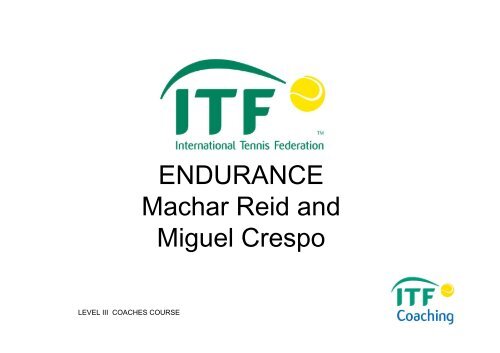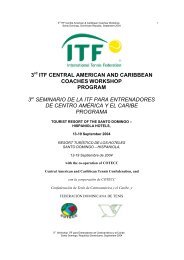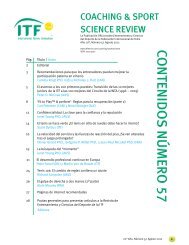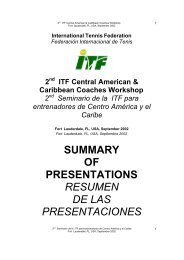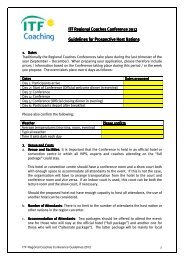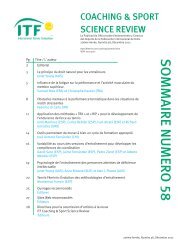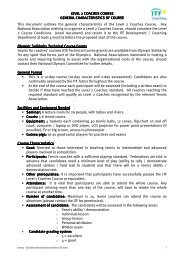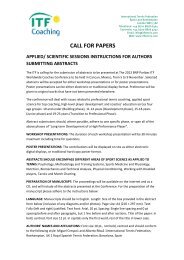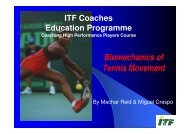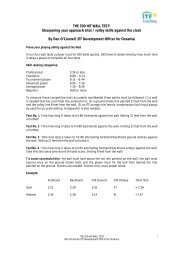6. Endurance - ITF Tennis - Coaching
6. Endurance - ITF Tennis - Coaching
6. Endurance - ITF Tennis - Coaching
Create successful ePaper yourself
Turn your PDF publications into a flip-book with our unique Google optimized e-Paper software.
LEVEL III COACHES COURSE<br />
ENDURANCE<br />
Machar Reid and<br />
Miguel Crespo
<strong>Endurance</strong> Definition -<br />
LEVEL III COACHES COURSE<br />
Practical<br />
�� Ability to sustain high levels of power<br />
output for a considerable period of time<br />
�� Ability to maintain a high level of power<br />
output repeatedly interspersed with<br />
recovery over a prolong period of time
LEVEL III COACHES COURSE<br />
<strong>Endurance</strong> Definition -<br />
Physiology<br />
�� Ability of working muscles to use high level of oxygen<br />
to produce energy to maintain the necessary power<br />
out over time<br />
�� Cardiac output = amount of blood deliver to the<br />
working muscles<br />
�� Arteriovenous oxygen differences = the amount of<br />
oxygen used by the working muscles
LEVEL III COACHES COURSE<br />
<strong>Tennis</strong>-specific endurance<br />
Semi-specific endurance<br />
Basic endurance<br />
ENDURANCE TRAINING GOALS
Training to Improve <strong>Endurance</strong><br />
�� Increase rate of oxygen deliver or transport to the<br />
working muscles (CENTRAL adaptations)<br />
�� Increase rate of oxygen utilization by the working<br />
muscles (PERIPHERAL adaptations)<br />
�� Of course, there are other adaptations e.g., greater<br />
use of fats and sparing glycogen, lower lactate<br />
production and/or enhanced elimination of lactate,<br />
etc, etc.<br />
LEVEL III COACHES COURSE
Training to Improve <strong>Endurance</strong><br />
�� Increase rate of oxygen deliver or transport to the working<br />
muscles (CENTRAL adaptations):<br />
- blood volume<br />
- size & contractility of heart<br />
- pulmonary diffusing capacity<br />
- concentration of hemoglobin<br />
- i.e. cardiac output<br />
LEVEL III COACHES COURSE
Training to Improve <strong>Endurance</strong><br />
�� Increase oxygen utilization by the working muscles<br />
(PERIPHERAL adaptations):<br />
- capillary density<br />
- number of myoglobin<br />
- size and number of mitochondria<br />
- oxidative enzymes<br />
- i.e. greater extraction of oxygen by working muscles<br />
LEVEL III COACHES COURSE
Good level of basic endurance a must …<br />
�� Player with high aerobic endurance fitness possesses:<br />
�� greater concentration of aerobic enzymes, increase<br />
mitochondria numbers, size and volume, increase myoglobin<br />
= enhancing oxygen extraction<br />
�� Greater blood volume, enhanced blood flow via increased<br />
capillarisation and ability to vasodilate, and stronger, bigger<br />
heart; enhanced CO = enhancing oxygen delivery<br />
LEVEL III COACHES COURSE
�� ** During recovery period, enhanced O2 processes help to<br />
quicker restore the depleted phosphagens, phosphagens,<br />
reducing the<br />
production of lactate<br />
LEVEL III COACHES COURSE<br />
** RESEARCH (Bogdanis Bogdanis et al., 1996)<br />
Athletes that are aerobically fitter<br />
improved PCr resynthesis<br />
better repeated sprint performance (power output)
PLAYER A<br />
LEVEL III COACHES COURSE<br />
HOWEVER …<br />
PLAYER B<br />
COMPARABLE LEVELS OF BASIC ENDURANCE<br />
METABOLIC RESPONSE TO TENNIS-SPECIFIC TENNIS SPECIFIC STIMULUS
Physiological profile of matchplay<br />
o Acyclic, short time intermittent workloads of the body's entire<br />
muscular system.<br />
o Points ≈ 3-10 10 seconds on a clay court (≈ ( half as long on grass).<br />
o Actual playing time ≈ 20-30% 20 30% on clay courts and to ≈ 10-15% 10 15% on fast<br />
court surfaces.<br />
o Average point duration between Kuerten and Ferrero, Ferrero,<br />
in the 2002<br />
French SF ≈ 7.3 seconds.<br />
LEVEL III COACHES COURSE
Physiological profile of matchplay II<br />
Prevalence of short rallies (≈ ( 80% of points involve < 4 strokes/player) +<br />
Oxidation of CHO<br />
and lipids<br />
There is an overall low demand on anaerobic-lactacid<br />
anaerobic lactacid energy supply …<br />
THEREFORE blood lactates remain low: 2.3-3.8mmol/l.<br />
2.3 3.8mmol/l.<br />
LEVEL III COACHES COURSE<br />
few long rallies (≈ ( 3% > 8 strokes per player) +<br />
rest periods.<br />
Supply energy to<br />
working muscles<br />
+<br />
High-energy High energy phosphates<br />
ATP and CP
HOW HIGH DO BLOOD LACTATE LEVELS RISE IN TENNIS??<br />
LA of elite tennis players in practice matches to be around 2.1±1.0 2.1 1.0 mmol/L. mmol/L.<br />
In matchplay, matchplay,<br />
LA were slightly higher at 2.9±1.3 2.9 1.3 mmol/L. mmol/L.<br />
The highest lactate value found was 7.5 mmol/L. mmol/L.<br />
CONCLUSION: contribution of the anaerobic-lactic anaerobic lactic energy system to the total<br />
energy supply during practice matches is 10% and increases to 20% 20%<br />
during<br />
matchplay.<br />
matchplay<br />
LEVEL III COACHES COURSE
BASIC ENDURANCE<br />
�� To improve the rate of delivery of oxygen (CO = HR x SV)<br />
�� To enhance SV, training should focus on enhancing the<br />
contractility of the heart muscle<br />
IMPROVED REGENERABILITY<br />
SHORT TERM – B/W RALLIES<br />
MEDIUM TERM – B/W 2 SAME-DAY SAME DAY TRG SESSIONS<br />
LONG-TERM<br />
LONG TERM – B/W 2 MATCHES<br />
PERFORMANCE-DETERMINING PERFORMANCE DETERMINING RELEVANCE 50-75% 50 75%<br />
LEVEL III COACHES COURSE
Training to improve basic endurance<br />
METHOD<br />
EXTENSIVE<br />
CONTINUOUS<br />
INTENSIVE<br />
CONTINUOUS<br />
LEVEL III COACHES COURSE<br />
CHARACTERISTICS GOALS<br />
Forms the largest part of Basic<br />
<strong>Endurance</strong> Training.<br />
Duration: 30-60 30 60 minutes<br />
Intensity: exclusively aerobic (1.0- (1.0<br />
2.5 mmol/l) mmol/l<br />
Frequency: 1 to 3-4 3 4 sessions/week<br />
depending on training phase<br />
Duration: 20-30 20 30 minutes<br />
Intensity: 2.5-5.0 2.5 5.0 mmol/l<br />
Frequency: 2 sessions/week<br />
Increase stroke volume<br />
Expand capillary network<br />
Reduce CHO metabolism during<br />
submaximal exercise<br />
Improve maximum oxygen<br />
uptake (VO 2 max)
CONTROLS OF ENDURANCE TRAINING INTENSITY<br />
METHOD<br />
HEART RATE<br />
(HR) =<br />
TRAINING<br />
PULSE<br />
STEP-BREATH<br />
STEP BREATH-<br />
RHYTHM (SBR)<br />
RATING OF<br />
PERCEIVED<br />
EXERTION<br />
(RPE)<br />
CHARACTERISTICS HOW TO MEASURE<br />
Formulas:<br />
HRR = (Max HR [220(m)/226(f)] – age) –<br />
Resting HR<br />
Extensive – 70% heart rate reserve (HRR)<br />
Intensive – 80% HRR<br />
# of steps taken when breathing in and out:<br />
Extensive – 4/4 SBR<br />
Intensive – 3/3 SBR<br />
With sufficient body and metabolic<br />
awareness:<br />
Extensive – zones 11-13 11 13<br />
Intensive – zones 14-16 14 16<br />
LEVEL III COACHES COURSE<br />
Carotid or radial pulse<br />
Not applicable to on court.<br />
Through experience.<br />
Applicable to most forms of<br />
training.
Semi-specific Semi specific endurance<br />
LEVEL III COACHES COURSE<br />
training<br />
�� Extension of basic endurance training, simulating more specifically specifically<br />
tennis’ tennis work:recovery cycle.<br />
�� Metabolic demands alternate between<br />
�� anaerobic-alactic<br />
anaerobic alactic (ie ie. . 5-10m 5 10m sprints);<br />
�� anaerobic-lactic anaerobic lactic (ie ( ie. . over 20m or uphill sprints) and;<br />
�� aerobic (ie ( ie. . running slowly during active recovery).<br />
�� PROTOCOL:<br />
�� FORMAT – fartlek or interval type work<br />
�� INTENSITY – HR ≈ 160bpm; blood lactates between 3-6 3 6 mmol/l; mmol/l;<br />
RPE ≈ 15-16 15 16
EMPHASIS<br />
AEROBIC<br />
AEROBIC/<br />
ANAEROBIC<br />
ANAEROBIC<br />
<strong>Tennis</strong>-specific <strong>Tennis</strong> specific endurance training<br />
LEVEL III COACHES COURSE<br />
CHARACTERISTICS EXAMPLE<br />
High density work performed at a<br />
sub-maximal sub maximal intensity (in aerobic<br />
range)<br />
High density work at an elevated<br />
intensity<br />
Coach-centred<br />
Coach centred drill training with<br />
intermittent work. Maximum<br />
intensity.<br />
Big “X”: : One player playing cross,<br />
the other down the line.<br />
Ball in constant play.<br />
Points played out of the hand<br />
Patterned stroking (6-10) (6 10) with<br />
active recovery (30-45 (30 45 seconds)
�� HIGHLY INTENSIVE DRILLS<br />
�� produce high levels of blood lactate (8-10mmol/l);<br />
(8 10mmol/l);<br />
�� fatiguing leading to coordinative failures, compromised<br />
movement/stroke mechanics such as:<br />
�� Slower runs to the ball<br />
�� Strokes hit greater distances away from the body<br />
�� Reduced stroke velocity<br />
�� Failure to reach certain balls<br />
LEVEL III COACHES COURSE
�� Adaptation EMPHASISES the promotion<br />
of oxygen extraction from the blood into<br />
the working muscles<br />
�� Exercise must either involve muscles used<br />
or movements specific to the game<br />
LEVEL III COACHES COURSE
Additional guidelines for tennis-specific tennis specific endurance<br />
training<br />
�� Aerobic base to be established<br />
�� Progressively increase the intensity of<br />
intervals sessions – ideally via greater speed<br />
or effort.<br />
�� Accumulated session work = 10-30 10 30 minutes<br />
�� First few repeats may serve as warm-ups warm ups<br />
until higher O2 uptake elicited<br />
LEVEL III COACHES COURSE
LEVEL III COACHES COURSE<br />
ASKING THE COACH… COACH<br />
IF TRAINING IS AFFECTED AND THEY DO NOT<br />
WHOLLY REFLECT MATCHPLAY DEMANDS, why are<br />
these drills used?
�� STAGED TRACK TEST<br />
�� MAXIMAL OXYGEN UPTAKE TEST<br />
�� TENNIS-SPECIFIC TENNIS SPECIFIC ENDURANCE TESTS<br />
�� COOPER TEST<br />
�� MULTI-STAGE MULTI STAGE FITNESS TEST<br />
LEVEL III COACHES COURSE<br />
ASSESSMENT
PERIODISATION OF ENDURANCE TRAINING<br />
�� Successive or temporal endurance development is the training ideal. ideal<br />
Time<br />
1-3 3 weeks<br />
4-6 6 weeks<br />
7-9 9 weeks<br />
Type<br />
Basic<br />
Semi-specific<br />
Semi specific<br />
<strong>Tennis</strong>-specific<br />
<strong>Tennis</strong> specific<br />
LEVEL III COACHES COURSE<br />
Method<br />
Extensive continuous<br />
Intensive continuous<br />
Fartlek<br />
Extensive run + sprints<br />
Baseline competitions<br />
Coach-centred<br />
Coach centred drills<br />
Frequency/Duration<br />
3/week for 45-60 45 60 minutes<br />
1/week for 20-30 20 30 minutes<br />
2/weeks for 45-60 45 60 minutes<br />
2/weeks for 45-60 45 60 minutes<br />
3/week for 30-45 30 45 minutes<br />
2/week for 20-30 20 30 minutes<br />
Training schedule for non-professional non professional tennis players to<br />
improve endurance in preparation for a season peak.
PCr regeneration during repeated<br />
sprint training (Dawson et al., 1997)<br />
�� 5 x 6 sec sprints (24 sec recovery)<br />
�� 27% of pre-exercise<br />
pre exercise PCr concentration<br />
after 5 th sprint<br />
�� ATP required to therefore be<br />
resynthesised by glyolytic and aerobic<br />
pathways<br />
�� 80% of PCr pre-ex pre ex levels recovered<br />
after 3 minutes<br />
LEVEL III COACHES COURSE
Anaerobic training (AnT ( AnT) ) intensity<br />
as dictated by oxygen tension at<br />
�� 90<br />
LEVEL III COACHES COURSE<br />
working muscles<br />
90-100% 100% VO 2max (HR = 6-8bpm 6 8bpm within MaxHR) MaxHR)<br />
= is<br />
most effective stimulus in regards to optimizing<br />
oxygen tension (utilisation ( utilisation) ) at the working muscles<br />
�� > 100% VO 2max = stimulus is no greater but greater<br />
accumulation of lactic. Subsequent reduction of<br />
workout duration may not be sufficient to induce an<br />
adaptation
�� 90<br />
Determining AnT intensity?<br />
90-100% 100% VO 2max = is speed that can be<br />
sustained continuously for up to 10-12 10 12 min<br />
�� BUT with intervals workout intensity of 90- 90<br />
100% VO 2max 2-3 3 minutes with subsequent<br />
rest of 2-3 2 3 min, the duration of the entire<br />
stimulus can be extended for > 20-40 20 40 min<br />
LEVEL III COACHES COURSE
LEVEL III COACHES COURSE<br />
What Intensity for<br />
Continuous?<br />
�� SV plateaus at 50%VO 2max – so to stress the<br />
heart work close or just below the anaerobic<br />
threshold point<br />
�� This is intensity that can be maintained for a<br />
prolonged period of time ~ 60 min<br />
�� Research also correlated an increase in<br />
ventilation to an increased VO 2max after 6 weeks<br />
of training – suggesting the importance of<br />
working at this anaerobic threshold level


